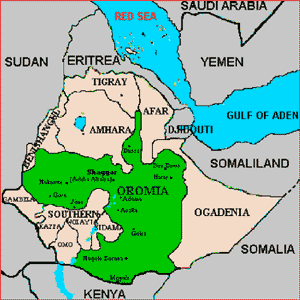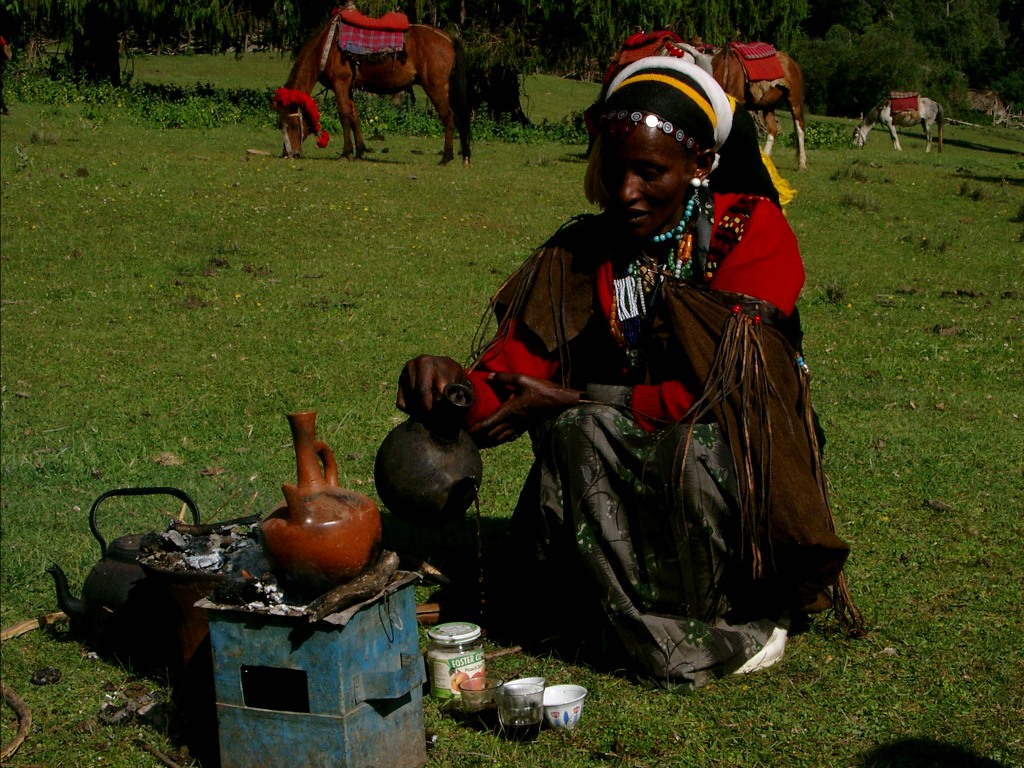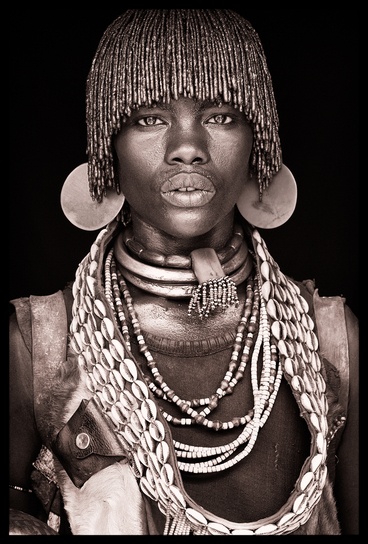|
|
HOME
- TABLE OF CONTENTS
- WAR ROOM -
THE GOSPEL
- BIBLE
STUDY - MORAL
ISSUES - KING
JAMES BIBLE - CULTS |
|
OROMO RELIGION OF ETHIOPIAEditor: Blesses Quietness Journal: The following is filled with half-truths. The Galla DO believe in spirits, and they hold a certain bird to be sacred, and they will run through the forest following the bird to see which way it turns in order to make a decision. The Galla (Oromo) also have reached a degree of ecumenism with Islam that is rare anywhere in the world. While they observe many Islamic Sharia laws, they also are drenched in animistic ritual and protocol. Islam allows this in any pagan religion where Islam invades, but Islam kills and tortures Christians in their domain. This is another witness to the power of the Gospel of Jesus Christ. |
THE RELIGION OF OROMO
 There
are three main religions in Oromia: traditional Oromo religion, Islam and Christianity.
Before the introduction of Christianity and Islam, the Oromo people practised
their own religion. They believed in one Waaqayoo which approximates to the English
word God. They never worshipped false gods or carved statues as substitutes. M.
de Almeida (1628-46) had the following to say: 'the Gallas (Oromo) are neither
Christians, moors nor heathens, for they have no idols to worship." The Oromo
Waaqa is one and the same for all. He is the creator of everything, source of
all life, omnipresent, infinite, incomprehensible, he can do and undo anything,
he is pure, intolerant of injustice, crime, sin and all falsehood. Waaqayoo is
often called Waaqa for short.
There
are three main religions in Oromia: traditional Oromo religion, Islam and Christianity.
Before the introduction of Christianity and Islam, the Oromo people practised
their own religion. They believed in one Waaqayoo which approximates to the English
word God. They never worshipped false gods or carved statues as substitutes. M.
de Almeida (1628-46) had the following to say: 'the Gallas (Oromo) are neither
Christians, moors nor heathens, for they have no idols to worship." The Oromo
Waaqa is one and the same for all. He is the creator of everything, source of
all life, omnipresent, infinite, incomprehensible, he can do and undo anything,
he is pure, intolerant of injustice, crime, sin and all falsehood. Waaqayoo is
often called Waaqa for short.
There are many saint-like divinities called ayyaana, each seen as manifestation of the one Waaqa or of the same divine reality. An effective relationship is often maintained between ayyaana and Oromo by Qaallu (male) and/or Qaalitti (female). A Qaallu is like a Bishop in the Christian world and an lmam in the Muslim world. He is a religious and ritual expert who has a special relationship with one of the ayyaana, which possesses him at regular intervals.
Although the office of Qaallu is hereditary, in principle it is open to anyone who can provide sufficient proof of the special direct personal contact with an ayyaana. In the Oromo society a Qaallu is regarded as the most senior person in his lineage and clan and the most respected in the society. He is considered pure and clean. He must respect traditional taboos (safuu) and ritual observances in all situations and in all his dealings and must follow the truth and avoid sin.
The Qaallu institution is one of the most important in the Oromo culture and society and is believed to have existed since mythical times. It is a very important preserver and protector of Oromo culture, more or less in the same way the Abyssinian Orthodox Church is the preserver of Abyssinian culture.
The Qaallu institution has political importance, even though the Qaallu himself does not possess political power as such and religion is distinctly separated from politics. The Qaallu village is the spiritual centre, where political debates are organized for the candidates for the Gadaa offices. Thus he plays both a spiritual and political role in the Gadaa system. For instance, during the fifth year of the Gadaa period, the Gadaa class in power honours the Qaallu by taking gifts and making their pledges of reverence. This is the Muuda or anointment ceremony. As the head of the council of electors, the Qaallu organizes and oversees the election of Gadaa leaders.
The Qaallu institution was once a repository of important ceremonial articles (collective symbols) in the Buttaa (Gadaa) ceremony, such as the bokku (sceptre), the national flag, etc. The national flag is made in the colours of the Qaallu turban (surri ruufa). The national flag had three colours - black at the top, red in the centre and white at the bottom. In the Gadaa, the three colours, black, red and white, represented those yet to enter active life, those in active life (Luba) and those who had passed through active five, respectively. The use of these symbols is prohibited by the colonial government.

The Oromo Qaallu must not be confused with the Amhara Qaallicha, who has a very different, much lower, social status. He is a vagabond who resorts to conjuring and black magic for his own benefit, (Knutsson, 1967). He is notorious for extracting remuneration by threats or other means. On the other hand, it is beneath the dignity of an Oromo Qaallu to ask his ritual clients for gifts or payment. The Abyssinian ruling class has confused the terms, thus disparaging the Qaallu socially and religiously by using the term depreciatingly.
The place of worship of Qaallu ritual house is called the Galma. Each ayyaana has its own Galma and its own special ceremonies. The Galma is usually located on a hill top, hill side or in a grove of large trees. Many of these sites are now taken up by Abyssinian Orthodox Church buildings or Mosques. Places of worship also include under trees, beside large bodies of water, by the side of big mountains, hills, stones, etc. This has been misrepresented by outsiders claiming that the Oromo worship trees, rivers, etc.
The believers visit the Galma for worship once or twice a week, usually on Thursday and Saturday nights. At this time the followers dance, sing and beat drums to perform a ritual called dalaga in order to achieve a state of ecstasy, which often culminates in possession. It is at the height of this that the possessing ayyaana speaks through the Qaallu's mouth and can answer prayers and predict the future.
Religious Oromo often made Muuda-pilgrimages to some of the great Qaallus and religious centres such as Arsi's Abbaa Muuda (father of anointment). Among the Borana Oromo Muuda pilgrimages are still common. Muuda pilgrimage is very holy and the pilgrims walk to the place of Abbaa Muuda with a stick in one hand and carrying myrrh (qumbii). All Oromo through whose village the pilgrims pass are obligedto give them hospitality. As the Mecca pilgrims are called Haj among Muslims, these Muuda pilgrims are cared Jila.
The Qaallu institution was weakened with the advent of colonialism to Oromia, which reduced contacts between various Oromo groups. The pilgrimage was prohibited. it became the policy to discourage and destroy Oromo cultural institutions and values. The Qaallu institution has suffered more during the last 14 years than it suffered during the previous 1 00 years. At this stage it faces complete eradication and Orthodox Church buildings are fast replacing Galmas. Just before the beginning of the harvest season every year, the Oromo have a prayer ceremony (thanksgiving festival) called irreessa. It once took place in river meadows where now the Abyssinian Orthodox Church takes its holy Tabot (tablets) for special yearly festivals, the 'timqat'. The lrreessa has become illegal and anybody who attempts to practise it is now likely to be imprisoned.
The Oromo believe that after death individuals exist in the form of a spirit called the 'ekeraa'. They do not believe in suffering after death as in Christianity and Islam. If one commits sin he/she is punished while still alive. The ekeraa is believed to stay near the place where the person once lived. One is obliged to pray to and to give offering by slaughtering an animal every so often to ones parents' ekeraa. The offerings take place near the family or clan cemetery, which is usually in a village.
Oromo people have been in constant contact with other religions like Islam and Christianity for almost the last 1000 years. For instance, the Islamic religion was reported to have been in eastern Shawa about 900
A.D. and Christianity even before that. However, in favour and defence of their own traditional religion, the Oromo have resisted these religions for quite a long time.
 However,
today the majority of the Oromo people are followers of Islam and Christianity,
while the remaining few are still followers of the original Oromo religion. It
is said that the Islamic religion spread in Oromia as a reaction to the Ethiopian
colonization. The Oromo accepted Islam and non-Orthodox Christianity en-masse
because they identified Abyssinian Orthodox Christianity with the oppressor and
also to assert their identity vis-a-vis Abyssinians. The Amhara spy monk, Atseme
wrote: "The Galla became Muslim for his hatred of Amhara priests." Bereket (1980)
also noted, "... Oromos in Arsi province accepted Islam in large number as a demonstration
of anti-Amhara sentiment and a rejection of all values associated with imperial
conquerors." A somewhat similar situation in the west was the acceptance of Islam
by many Afro-Americans in 1950s and 1960s, as a reaction to the racial discrimination
and oppression they faced from the white community and in search of an identity
different from that of the oppressor group.
However,
today the majority of the Oromo people are followers of Islam and Christianity,
while the remaining few are still followers of the original Oromo religion. It
is said that the Islamic religion spread in Oromia as a reaction to the Ethiopian
colonization. The Oromo accepted Islam and non-Orthodox Christianity en-masse
because they identified Abyssinian Orthodox Christianity with the oppressor and
also to assert their identity vis-a-vis Abyssinians. The Amhara spy monk, Atseme
wrote: "The Galla became Muslim for his hatred of Amhara priests." Bereket (1980)
also noted, "... Oromos in Arsi province accepted Islam in large number as a demonstration
of anti-Amhara sentiment and a rejection of all values associated with imperial
conquerors." A somewhat similar situation in the west was the acceptance of Islam
by many Afro-Americans in 1950s and 1960s, as a reaction to the racial discrimination
and oppression they faced from the white community and in search of an identity
different from that of the oppressor group.
There are many Oromo who are followers of Islam or Christianity and yet still practise the original Oromo religion. Bartels (1983) expressed this reality as follows: 'Whether they (Oromo) became Christians or Muslims, the Oromo's traditional modes of experiencing the divine have continued almost unaffected, in spite of the fact that several rituals and social institutions in which it was expressed, have been very diminished or apparently submerged in new ritual cloaks." Many used to visit, until very recently, the Galma and pay due respect to their clan Qaallu. This is more true in regions where Abyssinian Orthodox Christianity prevails.
Editor: Blessed Quietness Journal: So when Oromo Galla become Christians they still practice their pagan religion? Well, not the Arussi Galla. In fact, the Galla in Arussi, who do not become Christians, are abandoning the Oromo religion because they see that the Christians are healthier and happier. The Oromo Galla further south also reject the old religion when they are truly born again by faith in Jesus Christ. Oromo religion is full of terror of devils who are believed to be able to kill babies and drown people in the lakes on the Rift Valley.
It is typical that Roman Catholic priests and the Mullahs of Islam make little or no effort to separate the new convert from paganism to monotheism. This is true all over South America, Asia, and Africa. So let us take this rubbish with a grain of salt please.
I should know-- I lived in the Arussi Galla land around the south end of Lake Langano on the Rift Valley floor.
VIDEO:
OROMO THANKGIVING RITUAL AND DANCE
HEALING RITUAL OF OROMO
